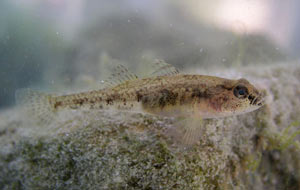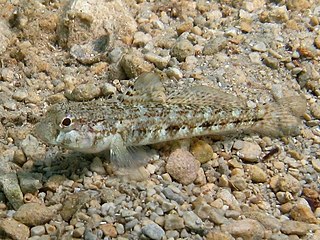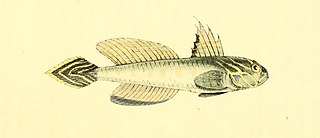Glossogobius hoesei, Hoese's goby, is a species of goby endemic to the Ayamaru Lakes in West Papua, Indonesia where it can be found on muddy or gravel substrates as well as in small tributary streams. This species can reach a length of 7 centimetres (2.8 in) SL. The specific name honours the ichthyologist Douglass Fielding Hoese of the Australian Museum in Sydney who has made an important contribution to the study of fishes in the order Gobiiformes.

Knipowitschia panizzae, the Adriatic dwarf goby, is a species of goby native to the coasts of the Adriatic and Ionian Seas where it has been recorded in Italy, Slovenia and Croatia with records from Greece needing to be confirmed. It prefers fresh and brackish waters with plentiful vegetation. This species can reach a length of 5.5 centimetres (2.2 in) TL. It is not known who the specific name honours but it is thought likely to be the Italian anatomist Bartolomeo Panizza (1785-1867), who studied the post-reproductive mortality of male sea lampreys.
Wheelerigobius wirtzi, the Cameroon goby, is a species of goby native to the Atlantic coast of Africa where it is so far known from Victoria Bay, Cameroon and São Tomé Island. This fish has been found at a depth of about 1 metre (3.3 ft) on a vertical rock face. The species can reach a length of 3.5 centimetres (1.4 in) SL. The specific name honours the ichthyologist and blenny taxonomist Peter Wirtz who collected the type specimen.
Neogobius pallasi, the Caspian sand goby or the Caspian monkey goby, is a species of fish native to fresh and brackish waters of the Caspian Sea basin including the Volga drainage up to the vicinity of Moscow. It has been introduced into the Aral basin. This species of goby can reach a length of 20 centimetres (7.9 in) SL. It is also important to local commercial fisheries.

Pomatoschistus bathi is a species of goby native to the eastern Mediterranean and the Sea of Marmara where it occurs at depths of from 7 to 14 metres on substrates with a sand or mud component. This species can reach a length of 3 centimetres (1.2 in) TL. It is found in Mediterranean Sea and Black Sea, with scattered records in southwestern France to Turkish Aegean Sea coast. The Bath's goby feeds on bosmiden, brine shrimps, lobster eggs, oyster eggs, zoobenthos and zooplankton. In 2013, it was listed as data deficient but was changed to Least Concern the following year because the population is thought to stable, it may be under-represented and there are no known threats. The specific name honours the German ichthyologist Hans Walter Bath (1924-2015).

Gobius roulei, Roule's goby, is a species of goby native to the eastern Atlantic Ocean and the Mediterranean Sea where it can be found at depths of from 320 to 385 metres. This species can reach a length of 8 centimetres (3.1 in) TL. The specific name honours the French zoologist Louis Roule (1861-1942) who was the collector of the type.

Couch's goby is a species of goby native to the northeastern Atlantic Ocean as far north as southern Great Britain and Ireland, the Mediterranean Sea and the Adriatic Sea where it can be found living under stones on muddy sand in inshore waters and in the intertidal zone. This species can reach a length of 7.7 centimetres (3.0 in) TL. The specific name and common name both honour Jonathan Couch (1789–1870), the Cornish ichthyologist and the author of A History of the Fishes of the British Islands published between 1862 and 1867.
Gobius gasteveni, Steven's goby, is a species of goby native to the eastern Atlantic Ocean where it is known to occur in the Irish Sea as far north as the Isle of Man, the western part of the English Channel south as far as Madeira and the Canary Islands. It can be found in areas with substrates of muddy sand with coarser deposits at depths of from 35 to 270 metres. This species can reach a length of 12 centimetres (4.7 in) TL. The common name and the specific name both honour the British ichthyologist G. A. Steven BSc FRSE (1901–1958), of the Plymouth Marine Laboratory, who worked extensively on the fish fauna of the English Channel and who identified this species as being new to that area.

Pomatoschistus knerii, Kner's goby, is a species of goby native to the western basin of the Mediterranean Sea and the Adriatic Sea. This species occurs in areas with soft substrates near to rocks or beds of seagrass. The specific name most likely honours the Austrian ichthyologist Rudolf Kner (1810-1869), who was a friend of the author Franz Steindachner.
Pomatoschistus lozanoi, Lozano's goby, is a species of goby native to the northeastern Atlantic Ocean from the North Sea to northwestern Spain and Portugal where it can be found at depths of from 70 to 80 metres. This species can reach a length of 8 centimetres (3.1 in) TL and is known to live for only two years. The specific name honours the Spanish zoologist Luis Lozano Rey (1878–1958).

Lesueurigobius is a genus of gobies native to the eastern Atlantic Ocean. The generic name honours the French naturalist Charles Alexandre Lesueur (1778-1846), for whom the type species, Lesueurigobius suerii, was named, Georg Duncker's name Lesueuria being preoccupied by a genus of comb jellies.
Ben-Tuvia's goby is a species of goby native to the Mediterranean Sea along the coast of Israel where it can be found on muddy sand bottoms at around a depth of 37 metres (121 ft). Both the specific name and the common name honour the Israeli ichthyologist Adam Ben-Tuvia (1919-1999) of the Hebrew University of Jerusalem, who collected type and who has made a significant contribution to the knowledge of the Mediterranean fish fauna.

Didogobius schlieweni is a species of goby native to the Adriatic Sea. The specific name honours the German ichthyologist Ulrich Schliewen of the Zoologische Staatssammlung München in Munich, the collector of the type and who suggested that the species be given the common name Andromeda Goby referring to the "nebula-like pattern of light and dark markings".

Lesueur's goby is a species of goby native to the Eastern Atlantic Ocean near the coasts of the Canary Islands and Morocco as well as in the Mediterranean Sea. This species occurs at depths down to 230 metres (750 ft) through most of its range, though the population in the Ionian Sea are found much deeper, at depths of from 322 to 337 metres. This species can reach a length of 5 centimetres (2.0 in) TL. This species can also be found in the aquarium trade The specific name honours the French naturalist Charles Alexandre Lesueur (1778-1846).
Elacatinus horsti, the yellowline goby, is a species of goby native to the western Atlantic Ocean and the Caribbean Sea.
Ginsburgellus novemlineatus, the Nineline goby, is a species of goby native to tropical reefs of the western Atlantic Ocean and the Caribbean Sea. It is frequently found associated with the sea urchin Echinometra lucunter, living underneath the urchin. This species grows to a length of 2.5 centimetres (0.98 in) TL. This species can also be found in the aquarium trade. This species is the only known member of its genus, the name of which honours the ichthyologist Isaac Ginsburg (1886-1975) of the U.S. National Museum who had an interest in gobies.
Hyrcanogobius bergi, the Volga dwarf goby, is a species of goby endemic to the Caspian Sea where it occurs in fresh, brackish and marine waters along the coast. Unusual for gobies, this species is almost a fully pelagic fish. H. bergi grows to a length of 3.6 centimetres (1.4 in) SL. This species is also the only known member of its genus. The specific name honours the Soviet zoologist Lev Berg (1876-1950) who described many new species of goby from the Caspian Sea.
Robinsichthys arrowsmithensis is a species of goby found on the Arrowsmith Bank in the Caribbean Sea at depths of from 92 to 596 metres. This species grows to a length of 2.3 centimetres (0.91 in) SL. This species is the only known member of its genus. The name of this genus honours C. Richard Robins (1928-2020), an American ichthyologist who was an important contributor to the study of gobies of the Americas.
Didogobius amicuscardis is a species of marine fish in the family Gobiidae, the gobies. It is endemic to São Tomé and Príncipe, where it occurs at depths from 7 to 25 m. The species was named and described by Kovačić and Schliewen in 2008.
Gobiopsis pinto, the snakehead goby, is a species of goby found in the western Indian Ocean.









